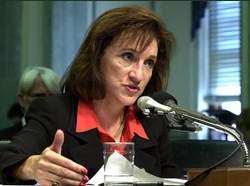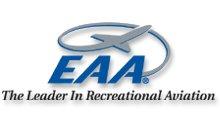Gives Breakdown Of New GA Charges Under Airline-Backed
Plan
Several members of the House Subcommittee on Aviation expressed
a wide range of concerns Wednesday to FAA Administrator Marion
Blakey on the administration’s proposed plan to revamp the
agency’s funding mechanism. Representatives with the
Experimental Aircraft Association tell ANN Blakey appeared at the
subcommittee’s hearing to discuss the Administration's FAA
Reauthorization Proposal.

But while there is evidence of mounting opposition to the
proposal, there is also a growing realization that all parties need
to work together to ensure FAA’s reauthorization and funding
for future modernization of the air traffic control system.
Among the elements of the proposal questioned were the
imposition of user fees and creation of a cost-effective system to
collect them; the three-to-four-fold increase in GA fuel taxes;
cutting the general fund contribution to fund FAA operations;
decreasing funds to increase capacity (runways and infrastructure);
and the inequitable cost-shift from airlines to general
aviation.
 When asked about user fees’
impact on general aviation, Blakey (right) pointed to the proposed
terminal fees at the 30 hub airports. She estimated the terminal
fee costs as being $3.86 for a 172, $5.07 for a Bonanza, and $15.93
for a Citation. EAA seriously questions whether the FAA could
efficiently collect such a small fee from numerous different
parties. For example, FAA has a long-standing policy that it is not
cost effective to collect international oceanic air traffic control
fees if the total does not exceed $250 per month. So how could they
possibly collect $3.86 cents in a cost-effective manner?
When asked about user fees’
impact on general aviation, Blakey (right) pointed to the proposed
terminal fees at the 30 hub airports. She estimated the terminal
fee costs as being $3.86 for a 172, $5.07 for a Bonanza, and $15.93
for a Citation. EAA seriously questions whether the FAA could
efficiently collect such a small fee from numerous different
parties. For example, FAA has a long-standing policy that it is not
cost effective to collect international oceanic air traffic control
fees if the total does not exceed $250 per month. So how could they
possibly collect $3.86 cents in a cost-effective manner?
When asked if GA would be harmed by the proposal, Blakey
answered, "No," and estimated total costs would be less than five
percent of the cost for annual airplane ownership. But there was no
mention of other fees proposed to pay for the costs of numerous
certification and registration activities.
Those would include: registering an aircraft ($130); replacing
an aircraft registration ($45); issuing an original dealer’s
aircraft certificate ($130); issuing an additional aircraft
certificate ($105); issuing/renewing a special registration number
($80/$50); recording a security interest ($130); recording a
security interest in aircraft parts ($130); issuing or replacing an
airman certificate ($50/$25); issuing an airman medical certificate
($42); and for providing legal title opinions pertaining to
aircraft transactions ($100).
And, of course, there’s the large fuel tax increase. The
EAA says most onerous is the fact that under the FAA’s
proposed bill, the Agency would have the authority to recover other
costs as they see fit in the future through the imposition of other
fees and there is no stated cap on the dollar amount for each
fee.
 Verne Ehlers (R-MI)
called the proposed large tax increase from 19.3 cents per gallon
to 70 cents per gallon on aviation fuel "unreasonable," and asked
how FAA could justify the 56.4-cent tax-per-gallon increase,
specifically referencing the recreational flyer and light-sport
aircraft.
Verne Ehlers (R-MI)
called the proposed large tax increase from 19.3 cents per gallon
to 70 cents per gallon on aviation fuel "unreasonable," and asked
how FAA could justify the 56.4-cent tax-per-gallon increase,
specifically referencing the recreational flyer and light-sport
aircraft.
Robin Hayes (R-NC) questioned why, under the provisions of the
proposal, there would be a 275 percent increase on operating
expenses for a pilot flying a Bonanza, but an 18 percent decrease
on the operations of a 747. "This is a terrible imposition on a
segment (GA) of the marketplace." He also cautioned members not to
repeat the mistake from several years ago when the luxury tax had
an adverse affect on general aviation.
John Mica (R-FL), ranking member of the Transportation and
Infrastructure Committee, appears to be the lone strong voice in
favor of not just shifting costs to general aviation, but also
eliminating the 19 percent general fund contribution. He has stated
that all users of the system should pay the entire bill, with no
general fund contribution. "I’m beginning to sound like the
‘lone stranger’ in supporting the
administration’s proposal," he said. "We've got to sober up
and realize that we must devise a new method of adequately funding
FAA and the nation's Next Generation air traffic control
system."
James Oberstar (D-MN), chairman member of the Transportation and
Infrastructure Committee, expressed serious reservations about the
funding aspects of the proposal that shifts costs from the airline
passenger to the general aviation "giant cash register in the
sky."
Other comments by members of the subcommittee:
 Subcommittee Chairman
Jerry Costello (D-IL) called the FAA’s proposed cuts to fund
increased capacity (runways and infrastructure) extremely
shortsighted, noting that adding runways and other airport capacity
projects are the best means of increasing system capacity and
preventing gridlock.
Subcommittee Chairman
Jerry Costello (D-IL) called the FAA’s proposed cuts to fund
increased capacity (runways and infrastructure) extremely
shortsighted, noting that adding runways and other airport capacity
projects are the best means of increasing system capacity and
preventing gridlock.
Peter Defazio (D-OR) called the administration’s proposed
general fund contribution (19 percent) "inadequate,’ noting
that as the costs go up, that fixed dollar amount will be a smaller
and smaller portion of the overall revenue. DeFazio also questioned
the wisdom of reducing the arrival and departure tax on
international travelers by 60 percent. "We’re cutting their
(international passengers) tax bill and shifting it over to
citizens of the U.S.," he said. The lost income is estimated at
$1.1 billion-$1.6 billion by 2012.
John Hall (D-NY) expressed concern about the funding for small
and growing airports that would be most important to the emerging
very light jet industry, as well as the move away from the excise
tax structure.
The subcommittee plans three more meetings this month to address
the financing proposal (March 21); operational and safety programs
(March 22); and the FAA’s Airport Improvement Program (March
28).
EAA continues to urge members to participate in efforts to put a
stop to the FAA’s user fee proposal.
 ANN's Daily Aero-Term (04.20.24): Light Gun
ANN's Daily Aero-Term (04.20.24): Light Gun Aero-News: Quote of the Day (04.20.24)
Aero-News: Quote of the Day (04.20.24) ANN's Daily Aero-Linx (04.21.24)
ANN's Daily Aero-Linx (04.21.24) Aero-News: Quote of the Day (04.21.24)
Aero-News: Quote of the Day (04.21.24) ANN's Daily Aero-Term (04.21.24): Aircraft Conflict
ANN's Daily Aero-Term (04.21.24): Aircraft Conflict






